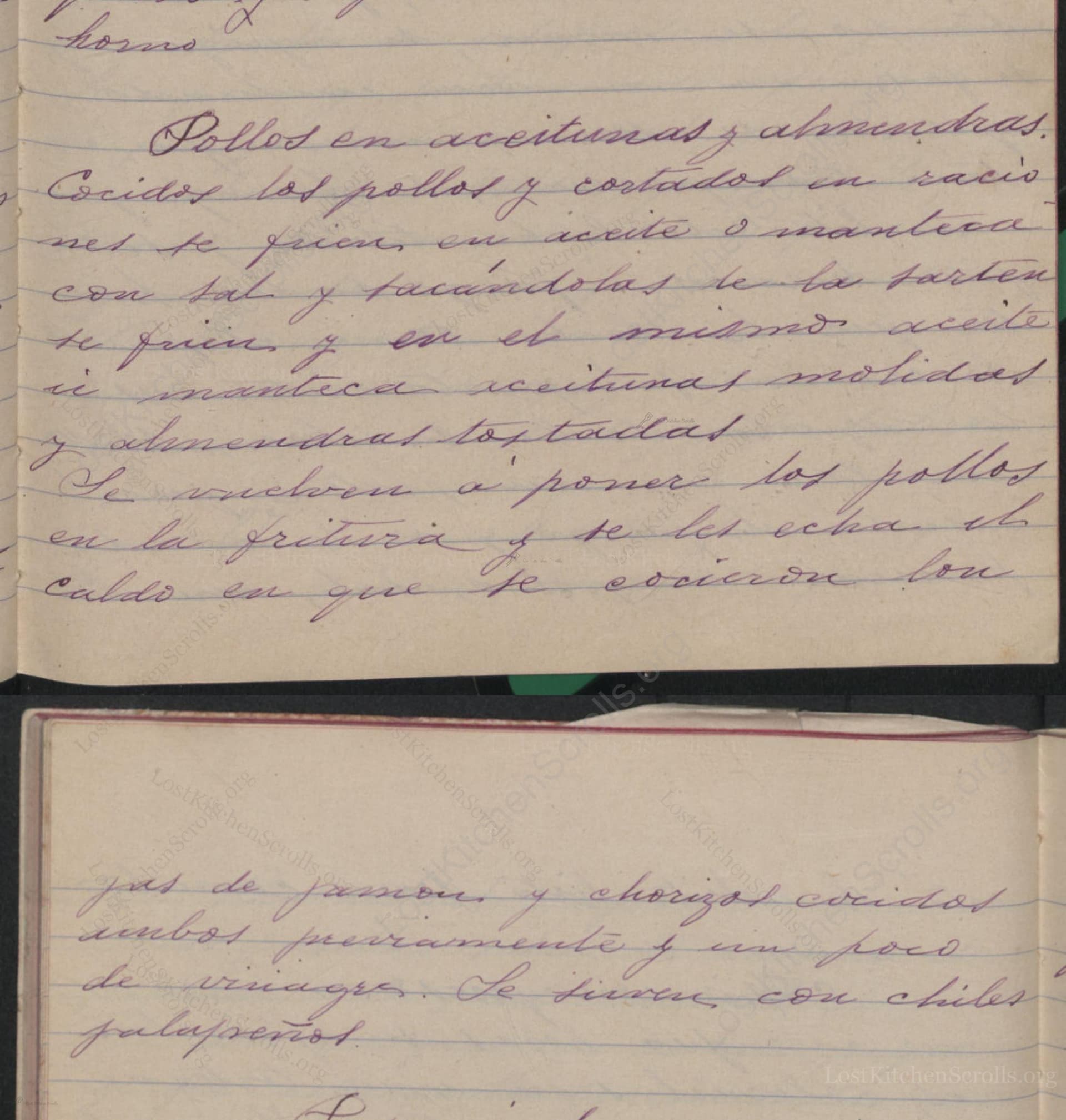Pollos En Aceitunas Y Almendras
"Chicken With Olives And Almonds"
From the treasured pages of Cuaderno de Recetas de Cocina de Hortensia Volante
Written by Hortensia Volante

Pollos En Aceitunas Y Almendras
"Cocidos los pollos y cortados en raciones se frien en aceite o manteca con sal y sacandolas de la sarten se frien en el mismo aceite aceitunas molidas y almendras tostadas. Se vuelven a poner los pollos en la fritura y se les echa el caldo en que se cocieron con jas de jamon, y chorizos cocidos ambos previamente y un poco de vinagre. Se sirven con chiles jalapeños."
English Translation
"Once the chickens are cooked and cut into portions, fry them in oil or lard with salt. After removing them from the pan, fry ground olives and toasted almonds in the same oil. Return the chicken pieces to the mixture and pour in the broth in which they were cooked, along with strips of ham and previously cooked chorizos, and a little vinegar. Serve with jalapeño peppers."
Note on the Original Text
Early 20th-century Mexican culinary manuscripts were concise, assuming a baseline of domestic skill and making little allowance for step-by-step novices. Quantities were rarely exact—'some olives' or 'a bit of vinegar'—and units were unspecified, as measurements depended on the cook's intuition. Spelling and vocabulary reflect the Spanish of the period and region—note 'aceitunas' (olives) and 'almendras' (almonds). Instructions were brief and practical, with little flourish, intended for those already familiar with the rhythms of the kitchen. Modern readers must 'read between the lines' to reconstruct the full method and adapt to current ingredient availability and kitchen equipment.

Title
Cuaderno de Recetas de Cocina de Hortensia Volante (1902)
You can also click the book image above to peruse the original tome
Writer
Hortensia Volante
Era
1902
Publisher
Unknown
Background
A charming early 20th-century manuscript brimming with delectable recipes, from croquetas to guiso de caracoles, lending a savory glimpse into the flavors of the era.
Kindly made available by
University of Texas at San Antonio
This recipe dates to 1902, from the 'Cuaderno de Recetas de Cocina' penned by Hortensia Volante, an early 20th-century Mexican manuscript. The cookbook reflects the eclectic gastronomic influences of turn-of-the-century urban Mexico, blending European (especially Spanish) and local flavors. At this time, printed cookbooks were rarities for many middle-class households, and handwritten recipe notebooks were treasured, evolving with each cook's hand. Dishes like this show a rich interaction between Spanish colonial heritage (olives, almonds, jamón, chorizo) and Mexican staples (jalapeño chiles), capturing a vibrant culinary crossroad.

In 1902, home cooks would have used a coal or wood-fired stove for simmering and frying. Chickens were boiled in large enamel or clay pots, and frying was often done in heavy cast iron or copper pans. Almonds and olives would have been pounded using a mortar and pestle, and all ingredients prepared by hand, from butchering poultry to chopping nuts. Knives were carbon steel, and measuring was by eye or with simple earthenware cups, rather than precise scales or measuring spoons. Pickled chiles, likely prepared at home or purchased from markets, would have finished the dish.
Prep Time
30 mins
Cook Time
1 hr 20 mins
Servings
6
We've done our best to adapt this historical recipe for modern kitchens, but some details may still need refinement. We warmly welcome feedback from fellow cooks and culinary historians — your insights support the entire community!
Ingredients
- 2 medium chickens (approx. 2.6 lb each)
- 1/4 cup olive oil or 3 1/2 tbsp clarified butter
- Salt, to taste
- 3.5 oz green olives, pitted and roughly crushed
- 2.8 oz almonds, toasted and coarsely chopped
- 2 cups chicken stock (from cooking the chickens)
- 1.75 oz jamón (Spanish ham) or prosciutto, diced and precooked
- 2.8 oz Spanish-style chorizo, sliced and precooked
- 1 tbsp wine vinegar
- Pickled jalapeño peppers, sliced
Instructions
- Begin by simmering 2 medium chickens (each about 2.6 lb) in lightly salted water until tender.
- Remove, allow to cool, then cut into serving pieces.
- Heat 1/4 cup olive oil or 3 1/2 tbsp clarified butter in a large skillet and fry the chicken pieces until golden with a pinch of salt.
- Remove the chicken and, in the same oil, briefly fry 3.5 oz pitted green olives, roughly crushed, and 2.8 oz toasted almonds, coarsely chopped.
- Return the chicken to the pan, then add about 2 cups of the reserved chicken cooking stock.
- Add 1.75 oz diced cooked jamón (Spanish ham or substitute prosciutto) and 2.8 oz sliced cooked Spanish-style chorizo.
- Pour in 1 tablespoon wine vinegar.
- Simmer for 5–10 minutes, allowing flavors to blend.
- Serve hot, garnished with sliced pickled jalapeño peppers.
Estimated Calories
480 per serving
Cooking Estimates
You should allow about 30 minutes to prepare the ingredients and workspace, and about 1 hour and 20 minutes for cooking, including simmering the chickens and finishing the dish. Each serving has about 480 calories, and this recipe serves 6 people.
As noted above, we have made our best effort to translate and adapt this historical recipe for modern kitchens, taking into account ingredients nowadays, cooking techniques, measurements, and so on. However, historical recipes often contain assumptions that require interpretation.
We'd love for anyone to help improve these adaptations. Community contributions are highly welcome. If you have suggestions, corrections, or cooking tips based on your experience with this recipe, please share them below.
Join the Discussion
Rate This Recipe
Dietary Preference
Main Ingredients
Occasions

Den Bockfisch In Einer Fleisch Suppen Zu Kochen
This recipe hails from a German manuscript cookbook compiled in 1696, a time whe...

Die Grieß Nudlen Zumachen
This recipe comes from a rather mysterious manuscript cookbook, penned anonymous...

Ein Boudain
This recipe comes from an anonymous German-language manuscript cookbook from 169...

Ein Gesaltzen Citroni
This recipe, dating from 1696, comes from an extensive anonymous German cookbook...
Browse our complete collection of time-honored recipes



